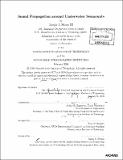| dc.contributor.advisor | Arthur B. Baggeroer. | en_US |
| dc.contributor.author | Sikora, Joseph J., III | en_US |
| dc.contributor.other | Woods Hole Oceanographic Institution. | en_US |
| dc.date.accessioned | 2010-10-05T14:29:46Z | |
| dc.date.available | 2010-10-05T14:29:46Z | |
| dc.date.copyright | 2009 | en_US |
| dc.date.issued | 2009 | en_US |
| dc.identifier.uri | http://hdl.handle.net/1721.1/58863 | |
| dc.description | Thesis (Ph. D.)--Joint Program in Applied Ocean Physics and Engineering (Massachusetts Institute of Technology, Dept. of Electrical Engineering and Computer Science; and the Woods Hole Oceanographic Institution), 2009. | en_US |
| dc.description | Includes bibliographical references (leaves 184-189). | en_US |
| dc.description.abstract | In the ocean, low frequency acoustic waves propagate with low attenuation and cylindrical spreading loss over long-ranges, making them an effective tool for underwater source localization, tomography, and communications. Underwater mountains, or seamounts, are ubiquitous throughout the world's oceans and can absorb and scatter acoustic energy, offering many interesting acoustic modeling challenges. The goal of the research performed in support of this thesis is to measure the acoustic scattered field of a large, conical seamount at long-range, and reconcile observations with 2-D range-dependent acoustic models, for the purpose of understanding the effects of highly range-dependent bathymetry. The Basin Acoustic Seamount Scattering Experiment (BASSEX) was conducted to measure the scattered fields of the two seamounts which form the Kermit-Roosevelt Seamount Complex in the Northeast Pacific Ocean during September and October of 2004. The experiment used fixed and ship-deployed acoustic sources transmitting m-sequence signals at 68.2 and 250 Hz carrier frequencies, with 35 and 83 Hz bandwidth, respectively. The receiver was a towed hydrophone array with 3 m sensor spacing, cut for 250 Hz. BASSEX is the first experiment to measure acoustic arrival patterns in the scattered field of a seamount at many locations at sound path ranges of order 500 km, utilizing a rich bathymetry and sound velocity database. Convergence zones in the forward-scattered field of seamounts at long-range are observed, created by higher order mode coupling and blockage. Acoustic ray arrival angles, travel times, and amplitudes show good agreement with parabolic equation (PE) acoustic modeling results inside the forward-scattered fields; in particular, simulated results are fairly accurate for weak surface-reflected-bottom-reflected acoustic rays. The width of the forward-scattered field is shown to span the projected width of a seamount. | en_US |
| dc.description.abstract | (cont.) Temporal coherence of ray amplitude inside a seamount scattered field could not be determined due to array movement issues, and should be the focus of future research to determine the stability of scattered acoustic rays for applications such as acoustic tomography. Robust adaptive beamforming methods are used to process hydrophone array data gathered in the BASSEX experiment. Non-stationarity in the observed noise field caused by array fluctuations and data acquisition system malfunctions motivate the use of a time varying Capon adaptive beam former, and strong acoustic harmonics from ship operations motivate the use of a frequency and steering angle dependent white noise gain constraint. In an effort to process snap-shot deficient data sets, the novel physically constrained maximum likelihood (PCML) beamformer was further developed and applied. By using orthonormal trigonometric eigenvector bases to determine the maximum likelihood spectral covariance matrix, the PCML beamformer computational efficiency is significantly increased. | en_US |
| dc.description.statementofresponsibility | by Joseph J. Sikora, III. | en_US |
| dc.format.extent | 189 leaves | en_US |
| dc.language.iso | eng | en_US |
| dc.publisher | Massachusetts Institute of Technology | en_US |
| dc.rights | M.I.T. theses are protected by
copyright. They may be viewed from this source for any purpose, but
reproduction or distribution in any format is prohibited without written
permission. See provided URL for inquiries about permission. | en_US |
| dc.rights.uri | http://dspace.mit.edu/handle/1721.1/7582 | en_US |
| dc.subject | Joint program in Applied Ocean Physics and Engineering. | en_US |
| dc.subject | Electrical Engineering and Computer Science. | en_US |
| dc.subject | Woods Hole Oceanographic Institution. | en_US |
| dc.title | Sound propagation around underwater seamounts | en_US |
| dc.type | Thesis | en_US |
| dc.description.degree | Ph.D. | en_US |
| dc.contributor.department | Joint Program in Applied Ocean Physics and Engineering | en_US |
| dc.contributor.department | Woods Hole Oceanographic Institution | en_US |
| dc.contributor.department | Massachusetts Institute of Technology. Department of Electrical Engineering and Computer Science | |
| dc.identifier.oclc | 429135622 | en_US |
